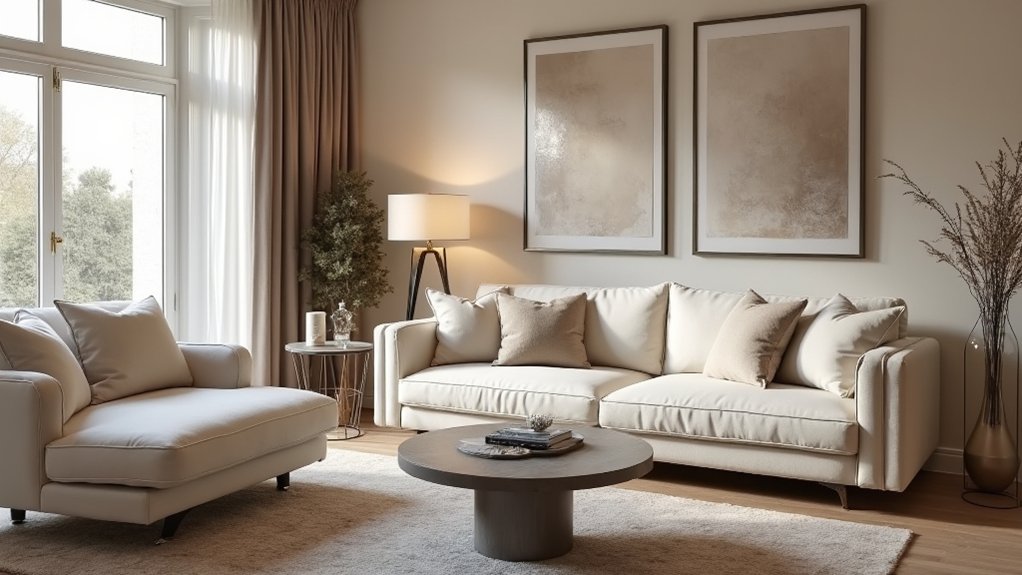
18 Beige and Grey Living Room Ideas That Feel Soft and Modern
A beige and grey living room achieves modern softness by blending neutral wall colors, layered textures, and sleek furnishings. Greige walls offer adaptable cohesion, while plush scatter cushions and woven throws create tactile depth. Textural accents, metallic finishes, and minimalist layouts enhance spatial clarity and visual interest. Coastal-inspired decor, statement artwork, and greenery introduce dynamic contrast without overpowering the palette. This combination balances comfort with sophisticated design. Further inspiration can reveal unique approaches for every style.
Key Takeaways
- Combine greige walls with layered textures like velvet cushions and woven throws for a cozy, modern foundation.
- Add bold accent walls in navy or emerald to create a striking focal point without overwhelming the neutral palette.
- Use minimalist furniture in neutral tones, such as beige boucle sofas and structured grey sofas, for a refined, uncluttered look.
- Incorporate natural light with sheer curtains and mirrors to enhance the soft, airy feel of beige and grey spaces.
- Integrate greenery and coastal-inspired decor, like driftwood accents and shell art, for dynamic contrast and tranquil elegance.
Rustic Farmhouse Charm
By utilizing a neutral palette of soft beige walls and a grey sofa, a living room can embody rustic farmhouse charm while adhering to contemporary design sensibilities.
The beige walls serve as a warm, versatile backdrop, allowing textural elements such as reclaimed wood beams, jute rugs, and shiplap paneling to take visual precedence. A grey sofa, preferably with a slipcovered silhouette, introduces understated sophistication and anchors the seating area.
Vintage-inspired decor—such as mason jars, distressed farmhouse signs, and plaid or knitted textiles—contributes layers of nostalgic character. The interplay of natural textures, combined with ample natural light filtered through light drapery and strategically positioned mirrors, creates an inviting, airy ambiance.
This approach balances coziness and authenticity, defining a modern rustic farmhouse aesthetic. Incorporating distressed wood furniture pieces can add character and tell stories through their surfaces, enhancing the room’s narrative.
Modern Minimalist Appeal
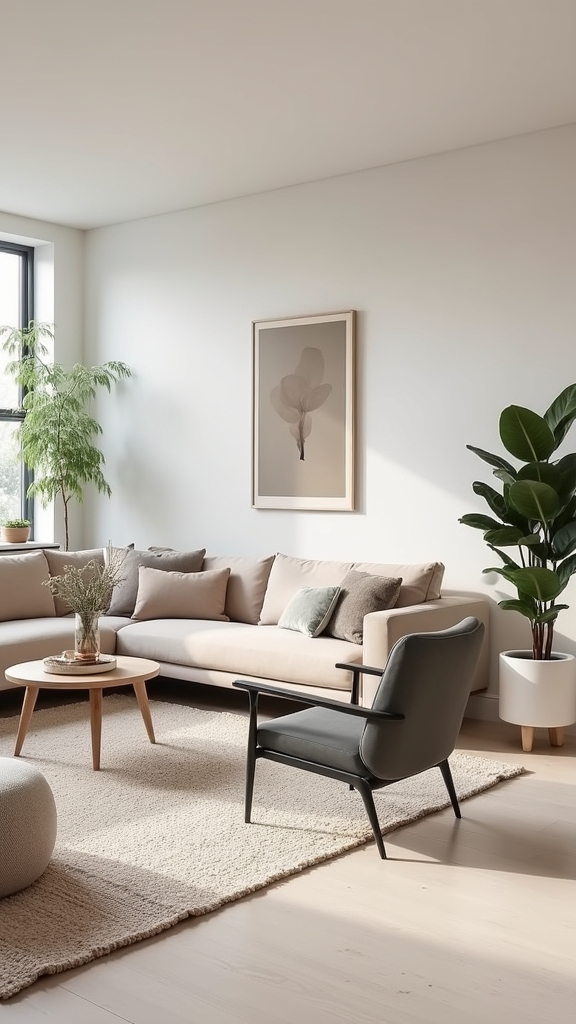
While rustic farmhouse charm celebrates organic textures and vintage accents, modern minimalist appeal shifts focus to refined simplicity and functional elegance. In a beige and grey living room, this look is defined by a neutral palette that incorporates soft beiges and varying shades of grey, establishing a calm and cohesive visual foundation. Clean architectural lines and an uncluttered layout reinforce spatial clarity, enhancing a sense of openness. Statement pieces—such as a structured grey sofa or minimalist monochrome artwork—introduce focal points without detracting from the room’s understated ambiance. Wall-mounted TVs save floor space and enhance minimalist aesthetics, contributing to a sleek and unobtrusive environment. Functional furniture choices, including low-profile coffee tables and streamlined accent chairs, uphold both utility and style. This approach guarantees the living space remains as functional as it is aesthetically sophisticated, embodying the essence of modern minimalist appeal.
Textural Layering for Depth
Textural layering introduces nuanced depth to a living room by strategically combining fabrics and finishes—think velvet, linen, leather, and wool for a curated tactile interplay. Layered rugs and throws not only enhance comfort but also anchor the space visually, especially within a restrained beige and grey palette. This approach fosters cohesion while offering subtle opportunities for pattern and material experimentation that align with contemporary design trends. To achieve a sophisticated and inviting atmosphere, balance textures like leather and velvet, ensuring a harmonious interplay of materials.
Mixing Fabrics and Finishes
Although neutral palettes like beige and grey offer a timeless backdrop, depth and visual intrigue are best achieved through the strategic layering of fabrics and finishes.
Mixing materials such as plush velvet, soft cotton, and cozy wool introduces a tactile richness, while the juxtaposition of matte and glossy surfaces raises the spatial dynamic.
Employing textiles—think a beige shag rug combined with grey linen curtains—creates a cohesive yet distinctly layered appeal.
Accenting with patterned throw pillows and tactile throws injects nuanced texture, establishing subtle visual contrasts that energize the environment.
Incorporating diverse finishes, such as pairing a smooth glass coffee table with a rough-hewn wooden side table, enhances both texture and balance.
This deliberate approach to layering guarantees the living room feels curated, modern, and effortlessly inviting.
Layered Rugs and Throws
By layering rugs of varying materials—such as positioning a plush beige area rug atop a textured grey foundation—a living room gains instant depth and dimension.
This technique of layered rugs introduces nuanced visual interest, enhancing the tactile experience and grounding the neutral palette.
Integrating throws in diverse fabrics, like soft wool and chunky knits, further enhances the sense of comfort and warmth.
The interplay of patterns—such as geometric prints juxtaposed with solid hues in pillows and throws—contributes to a dynamic, contemporary aesthetic.
Utilizing different shades of beige and grey in both rugs and throws establishes a sophisticated, harmonious environment.
Textural layering remains a key trend, ensuring the space feels cohesive, inviting, and modern without veering into monotony or visual coldness.
Coastal-Inspired Serenity
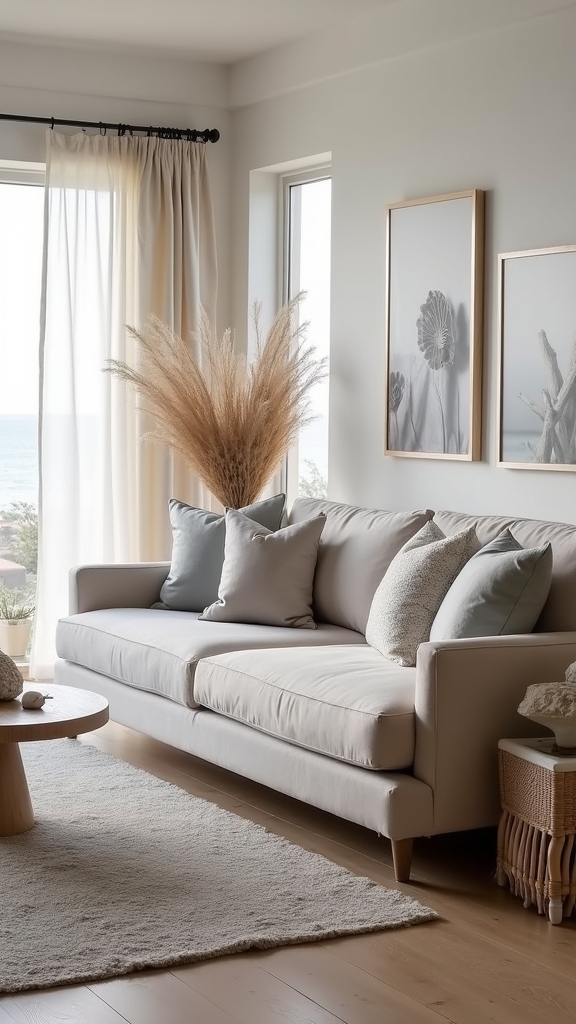
A palette anchored in soft sand and stone tones establishes a tranquil foundation, ideal for cultivating a coastal-inspired living space.
Breezy striped accents in textiles introduce visual rhythm and nod to maritime influences, while driftwood and shell decor infuse organic texture and subtle coastal references.
This approach achieves a balanced interplay between contemporary serenity and natural elements, reflecting current trends in biophilic and coastal interior design.
Soft Sand and Stone
Serenity defines the “Soft Sand and Stone” concept, where a coastal-inspired palette of creamy beiges and light greys establishes a tranquil, contemporary foundation.
In this approach, soft grey walls serve as a versatile backdrop, amplifying natural light and visually expanding the living area. A beige sofa anchors the space, offering both warmth and subtle contrast within the scheme.
Layered natural textures—jute rugs, driftwood accents, and linen upholstery—reinforce the coastal narrative while maintaining a refined, modern sensibility.
Carefully curated decor, including seashell elements and understated beach-themed artwork, integrates oceanic references without overwhelming the aesthetic.
Light, sheer curtains enhance luminosity and preserve the airy atmosphere, ensuring the overall effect remains relaxed yet heightened—a sophisticated nod to current coastal interior design trends.
Breezy Striped Accents
Although grounded in a neutral palette, the introduction of breezy striped accents infuses a beige and grey living room with subtle coastal character and enhanced visual rhythm.
Soft, light-colored striped textiles—such as throw pillows or sheer curtains—deliver a refined nautical touch while preserving the room’s tranquil ambiance. Striped area rugs and wall art further amplify visual interest without overpowering the understated scheme.
These breezy patterns, especially when rendered in hues of light blue or seafoam green, provide invigorating chromatic contrast and reinforce a serene, inviting atmosphere.
Integrating striped elements with natural materials like jute or linen enhances the organic sensibility, aligning with contemporary trends toward tactile and sustainable decor.
The judicious use of stripes raises coastal-inspired serenity within soft, modern interiors.
Driftwood and Shell Decor
When driftwood accents are incorporated into a beige and grey living room, they introduce organic texture and a rustic, tactile quality that aligns with contemporary coastal design trends.
The interplay between weathered driftwood and smooth shell decor enhances the space, creating visual depth while remaining true to a modern, understated palette. Coastal-inspired decor thrives in these neutral environments, where subtle references to the shoreline add sophistication without overpowering the serenity of the room.
Thoughtful integration of natural elements fosters a relaxed, harmonious atmosphere, balancing form and function.
- Sculptural driftwood accents as coffee table centerpieces or wall art
- Shell-inlaid decorative bowls on console tables
- Framed shell art blending with soft grey and beige walls
- Layered textures: woven rugs, linen upholstery, driftwood, and shells
- Minimalist coastal-inspired decor for a tranquil, curated look
Metallic Accents for Luxe Touch
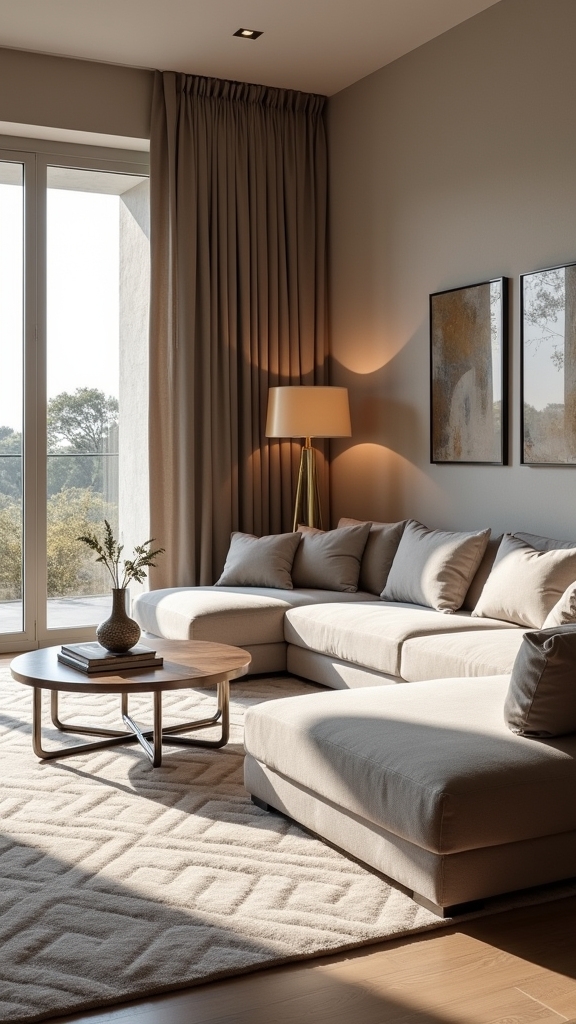
Metallic accents introduce a heightened layer of sophistication to beige and grey living rooms, capturing current trends in interior design that favor subtle glamour. When strategically integrated, gold or silver decorative elements—such as lamp bases, picture frames, or sculptural vases—reflect light, amplifying brightness and creating an open, airy ambiance. The interplay of metallic accents with soft furnishings in neutral hues generates visual interest and maintains a cohesive, contemporary aesthetic. By incorporating metallic finishes through accent pieces like throw pillows or trays, designers achieve a sense of understated luxury without overpowering the gentle palette. Carefully positioned metallics serve as focal points, directing attention and adding dimensionality to the spatial composition. This trend-forward approach enhances classic beige and grey schemes with modern, luxurious detail. Additionally, the use of black lighting fixtures can create striking focal points against beige, enhancing the chic ambiance and adding depth to the living space.
Soft Neutral Wall Colors
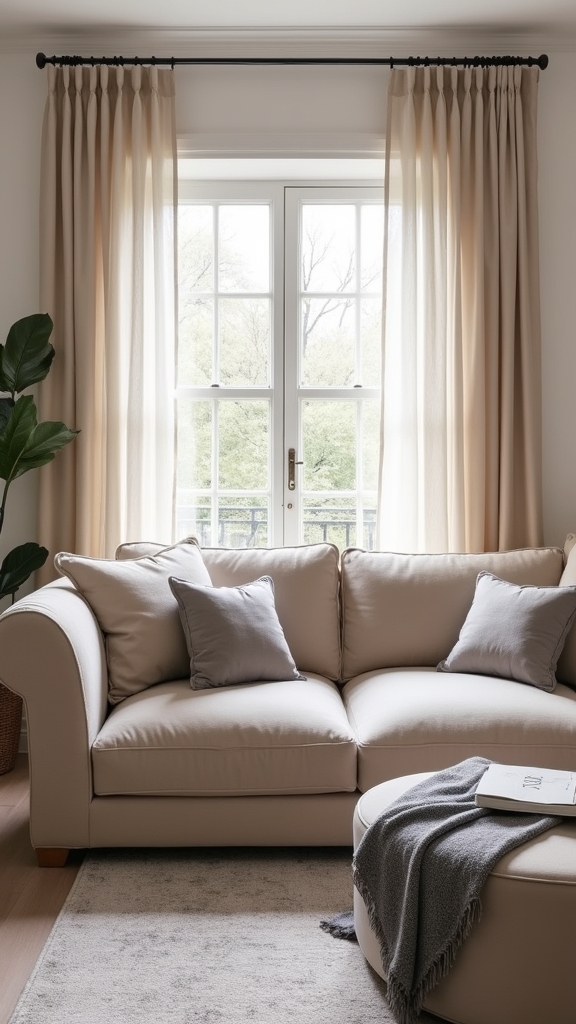
Soft neutral wall colors remain a cornerstone in contemporary living room design, with greige emerging as a favored choice for its adaptability and understated elegance. Light beige enhances spatial luminosity, optimizing the effect of natural light and creating an expansive feel. For added depth, accent walls in taupe introduce subtle contrast while preserving a cohesive and tranquil palette. Incorporating beige curtains can further enhance the warmth and neutrality of the space, complementing grey walls without overwhelming them.
Choosing Greige for Walls
Blending the understated sophistication of grey with the warmth of beige, greige has emerged as a preferred wall color among interior designers seeking versatile, soft neutrals.
Greige walls deliver a modern yet inviting atmosphere, acting as a chameleon within contemporary living rooms. This neutral colour adapts effortlessly to both warm and cool palettes, making it a strategic choice for spaces where flexibility and cohesion are desired.
Greige not only amplifies natural light but also creates a serene, balanced backdrop for statement furnishings and curated decor.
- Enhances ambient light, making rooms feel brighter and more expansive
- Harmonizes easily with cream, taupe, and muted pastel accents
- Supports both minimalist and maximalist design approaches
- Offers a calming, sophisticated canvas for art and textiles
- Facilitates seamless seasonal decor changes
Brightness With Light Beige
When aiming to maximize spatial luminosity and a sense of openness, light beige wall colors offer an effective solution rooted in contemporary design principles. This soft neutral acts as a luminous backdrop, reflecting natural light and amplifying the perception of space—an essential approach in modern living rooms. When paired with grey walls or grey furnishings, light beige introduces a harmonious balance that feels both sophisticated and inviting. Its versatility allows for seamless integration with various decor styles and color palettes, supporting evolving trends in interior design.
| Design Element | Impact in Space |
|---|---|
| Light Beige Walls | Enhances brightness and spaciousness |
| Grey Furnishings | Adds a modern, balanced contrast |
| Natural Light | Maximized by reflective surfaces |
| Versatile Styling | Adapts to multiple color schemes |
| Cozy Atmosphere | Softens modern, minimalist interiors |
Accent Walls in Taupe
Taupe accent walls introduce a nuanced layer of warmth and sophistication to modern living rooms, serving as a strategic design element within the soft neutral palette.
As a versatile hue, taupe effectively bridges beige and grey, creating a seamless shift between furnishings and architectural features. This approach leverages the subtle character of taupe to deliver visual depth while maintaining a calm, contemporary atmosphere.
Accent walls in taupe are particularly effective in rooms aiming for a tranquil ambiance without sacrificing design interest or cohesion. The following design applications illustrate the impact of taupe accent walls:
- Enhances beige and grey furniture with a grounded, harmonious backdrop
- Adds architectural definition while preserving a soft, inviting mood
- Complements layered textures, such as boucle or linen upholstery
- Supports Scandinavian, rustic, and minimalist decor schemes
- Raises natural material accents, like wood or stone
Mixing Patterns and Prints
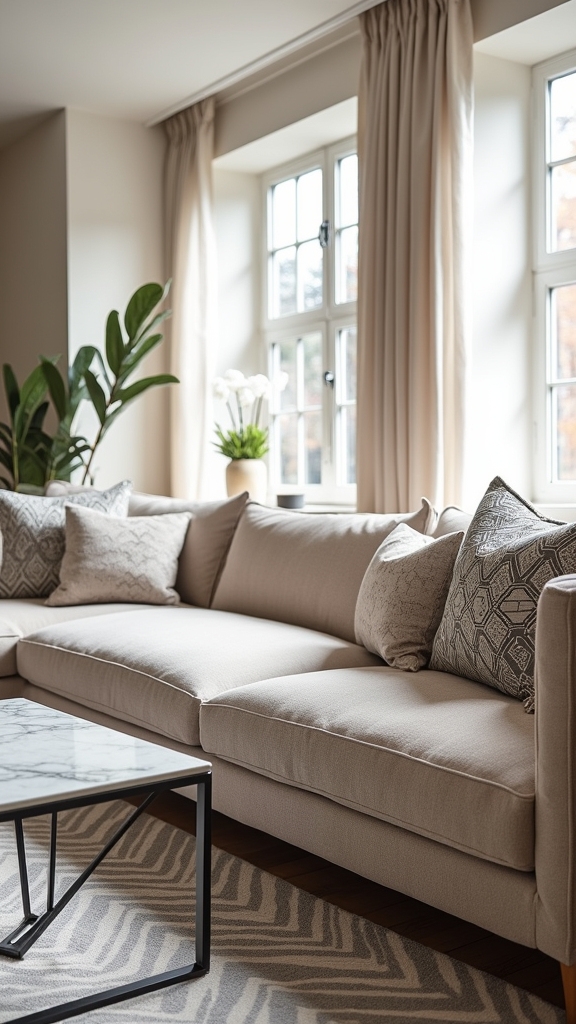
How can one enhance the sophistication of a beige and grey living room? Mixing patterns is a refined technique to inject visual interest and depth, ensuring the neutral palette remains dynamic yet harmonious.
By layering geometric rugs with organically patterned cushions, designers introduce tactile and visual contrast, augmenting the room’s softness without overpowering its serene ambiance.
Adhering to a cohesive color story—employing only variations of beige and grey—prevents pattern clashes, maintaining a unified aesthetic.
Strategic use of scale is essential; bold, oversized prints anchor the space as focal points, while petite motifs add subtle complexity.
Patterned accessories, such as throw pillows or contemporary art, offer flexibility for seasonal updates and personal expression, allowing the living room to evolve while preserving its modern, tranquil appeal.
Incorporating natural materials and houseplants not only complements the neutral tones but also adds warmth and vitality, enhancing the room’s inviting atmosphere.
Stone Sofa Living Room Looks
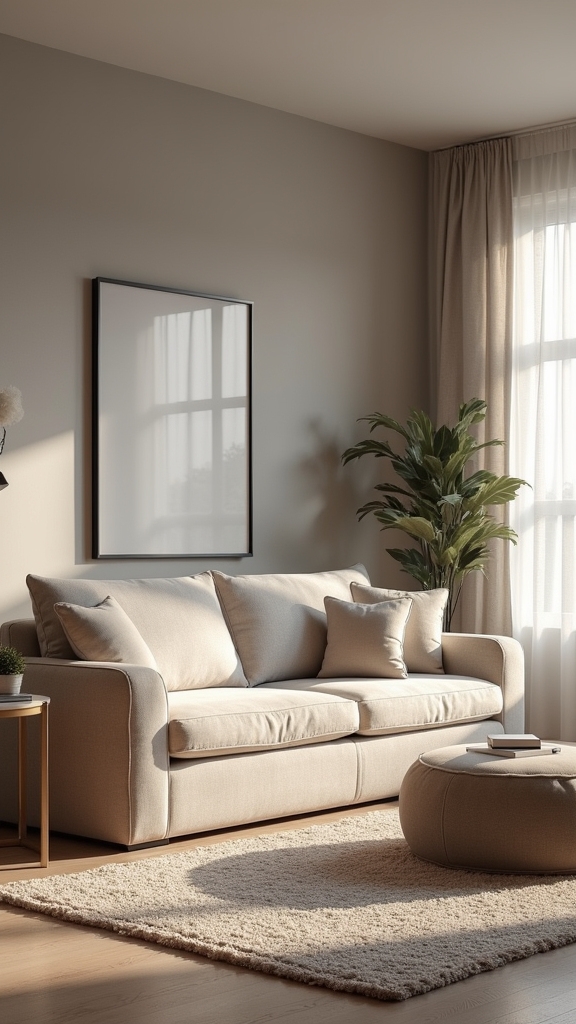
Although unconventional, a stone sofa instantly commands attention as the focal point of a modern living room, pairing seamlessly with the understated elegance of beige and grey palettes.
This bold design choice capitalizes on the interplay between hard surfaces and soft textures, elevating grey living room ideas with a sculptural touch. Designers often balance the tactile solidity of a stone sofa by integrating plush elements and thoughtful spatial planning.
The following features exemplify how a stone sofa can be harmonized within a contemporary, neutral setting:
- Light beige or greige walls serve as a luminous canvas for the stone’s natural hues.
- A textured grey carpet grounds the composition while adding visual depth.
- Layered rugs and tactile cushions soften the sofa’s striking presence.
- Open-plan furniture arrangements foster sociability and flow.
- Minimal accessories keep the focus on the architectural centerpiece.
- Incorporating luxurious fabrics like velvet and silk for cushions or drapes can enhance the sophistication and elegance of the setting.
Warmth With Earthy Tones
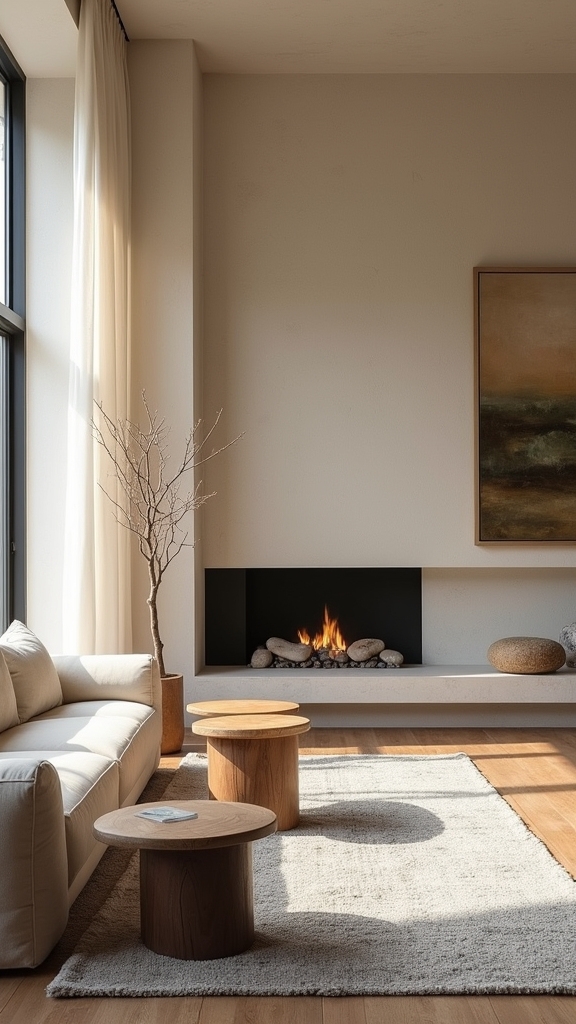
Earthy tones introduce an essential layer of warmth to contemporary living rooms anchored in beige and grey. Integrating hues such as terracotta and olive green with a foundation of warm beige delivers a sophisticated, lived-in appeal. These earthy tones soften the visual impact of cooler greys, ensuring the space avoids a sterile or austere atmosphere. Employing natural materials—wood for flooring, stone for accent walls—adds organic texture and tactile interest, further enhancing a serene ambiance. Layering soft furnishings in earthy colors, like cushions and throws, contributes to the room’s depth and comfort. This balanced palette is trend-forward, reflecting a conscious embrace of nature-inspired design while remaining versatile. Adding wooden furniture, such as farmhouse tables, enhances warmth and charm, further solidifying the rustic appeal.
Greige for Versatility
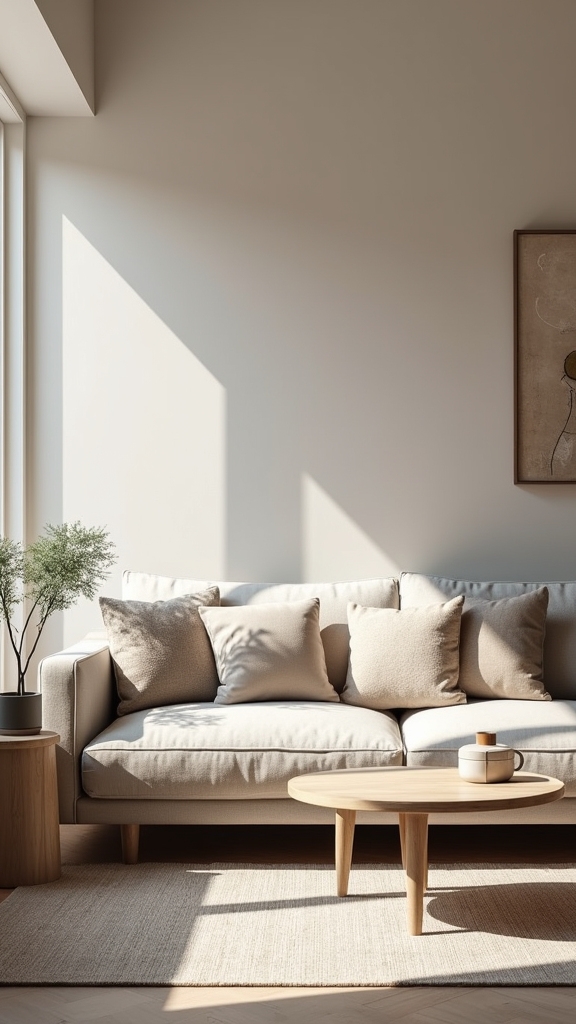
Greige excels in open-plan living areas, providing a seamless, cohesive backdrop that enhances spatial flow. Its understated tone allows for dynamic interplay with layered textures—think boucle upholstery, matte ceramics, or woven rugs—amplifying visual interest without overpowering the scheme. This approach aligns with current trends favoring adaptable, tactile environments that balance sophistication and comfort. Incorporating multi-functional pieces such as storage ottomans or convertible sofas can further enhance the versatility and utility of a greige-themed living room.
Greige in Open Spaces
A strategic blend of grey and beige, greige emerges as a sophisticated neutral that excels in open-plan living environments. Its adaptable colour palette is especially effective in connecting multiple functional zones, ensuring seamless visual continuity.
Greige’s understated elegance enhances spatial perception, making open spaces feel expansive and cohesive. This versatile hue supports contemporary and classic aesthetics, providing a flexible foundation for evolving design trends.
- Greige walls unify adjacent zones, such as living and dining areas, for a harmonious flow.
- The neutral tone acts as a backdrop, highlighting statement furnishings without competing for attention.
- It supports a wide spectrum of accent colours, enabling easy seasonal or personal updates.
- Enhances natural light, amplifying the spacious feel of open layouts.
- Works with diverse materials and finishes for layered, modern appeal.
Pairing Greige With Textures
By integrating an array of textures, designers boost the understated appeal of greige, transforming neutral living rooms into visually compelling environments.
Greige, a versatile fusion of grey and beige, serves as a sophisticated canvas that responds dynamically to tactile layering. Employing plush rugs, woven throws, and smooth furniture finishes introduces visual depth and prevents the space from appearing flat.
Designers often juxtapose velvet cushions against linen drapes or matte ceramics with glossy metallics to enrich the sensory experience. This multidimensional approach enhances greige’s adaptability, allowing it to complement both warm and cool palettes—whether paired with earthy tones or vibrant accents.
Ultimately, layering textures within a greige scheme heightens comfort and style, crafting modern living rooms that are both calming and richly detailed.
Bold Accent Walls
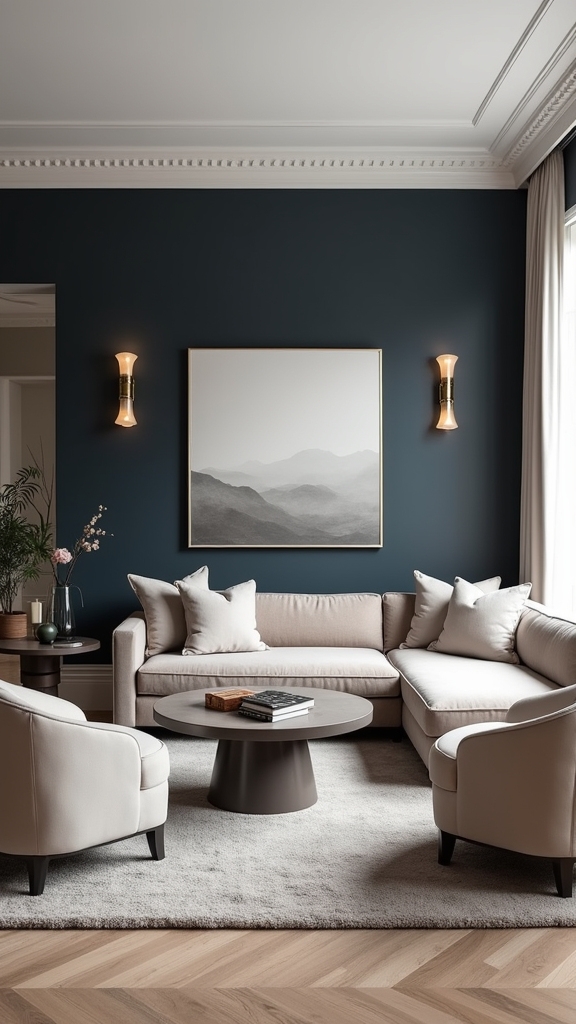
While neutral palettes like beige and grey dominate contemporary living rooms, introducing a bold accent wall enhances the design by establishing a striking focal point.
This approach maintains a soft and modern aesthetic while infusing the space with visual energy and depth.
Strategic placement of bold accent walls—especially using darker greys, navy, or emerald hues—creates contrast without overwhelming the subtle beauty of beige and grey.
A bold accent wall in deep navy or emerald brings contrast, highlighting beige and grey without overpowering their understated elegance.
Textured wallpaper and geometric patterns further boost the room’s dynamism, while a matte finish adds a cozy, inviting touch.
Designers often position these accent walls behind key architectural features to anchor the space.
A geometric patterned rug can further contribute to the overall aesthetic and modernize the look.
- Deep navy or emerald accent wall for dramatic contrast
- Matte finishes to soften bold colors
- Textured wallpaper for added depth
- Geometric patterns to modernize the look
- Placement behind fireplaces or statement furniture
Plush Scatter Cushions
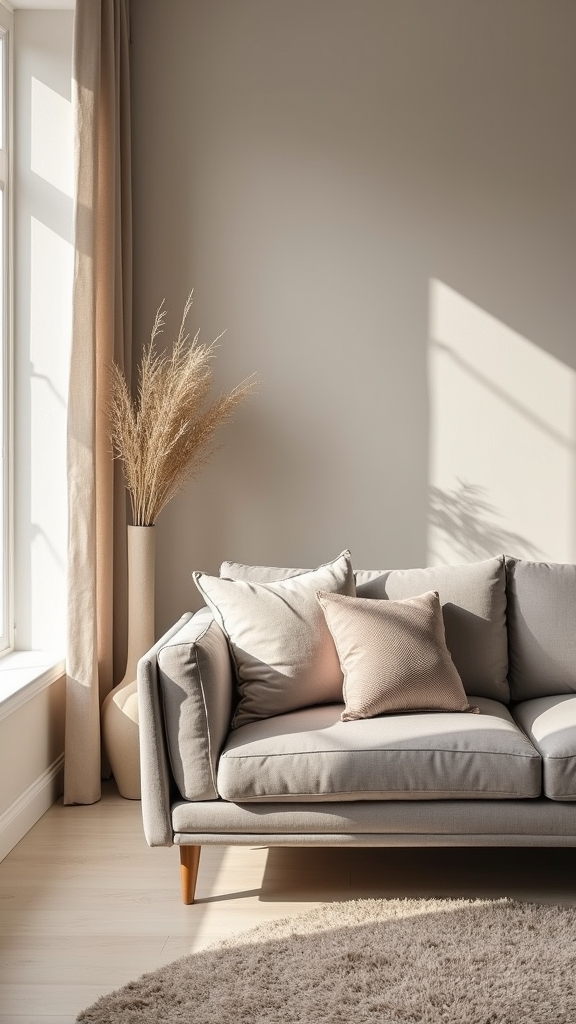
Plush scatter cushions offer an opportunity to introduce tactile contrast by mixing fabrics such as velvet, linen, and faux fur within a neutral palette.
Layering cushions in varying tones of beige and grey, accented with subtle patterns, creates a sophisticated yet inviting depth.
Pattern interplay, from understated geometrics to organic motifs, reflects current trends while maintaining visual harmony in contemporary living spaces.
Mix Textures and Fabrics
A selection of plush scatter cushions in a beige and grey living room introduces layered comfort and sophisticated visual depth, aligning with contemporary design trends.
Integrating multiple textures through carefully chosen fabrics enhances the tactile and aesthetic profile of the space. Interior designers recommend an interplay of soft and structured materials to create dimension and interest.
By varying the textiles and detailing, scatter cushions become focal points that reinforce the room’s modern sensibility while ensuring a cozy ambiance.
- Velvet scatter cushions add lustrous sheen and a rich, tactile contrast.
- Linen and cotton options introduce a crisp, breathable texture to the palette.
- Cushions in mixed patterns unify beige and grey hues with subtle dynamism.
- Layering different sizes enhances ergonomic comfort and visual intrigue.
- Embellishments like pom poms or fringe soften the overall aesthetic.
Layer Neutral Tones
Neutral layering defines an enhanced living room aesthetic, where plush scatter cushions in gradients of beige and grey introduce nuanced depth and softness. By curating cushions in various neutral tones, designers achieve a sophisticated tonal harmony that feels inviting yet restrained. Select textiles such as velvet, linen, and knits to enrich the tactile experience, while maintaining a cohesive neutral palette. Clustered arrangements on sofas or accent chairs amplify comfort, promoting a relaxed yet polished ambiance. Utilizing an abundance of cushions not only adds visual interest but also reinforces a sense of coziness. When strategically layered, neutral cushions become integral to modern interiors, bridging comfort with contemporary style.
| Cushion Material | Neutral Shade | Arrangement Idea |
|---|---|---|
| Velvet | Light Beige | Clustered on Corner |
| Linen | Warm Grey | Layered Centrally |
| Knitted | Taupe | Scattered Asymmetry |
| Faux Fur | Cool Grey | Paired at Ends |
Play With Patterns
Many contemporary living rooms benefit from the dynamic interplay of patterned scatter cushions, which punctuate beige and grey palettes with visual intrigue. Thoughtfully selected cushions introduce both depth and tactile variety, elevating the overall scheme beyond flat neutrals.
By layering textiles—velvet, linen, and cotton—designers achieve a sophisticated, inviting atmosphere that feels soft yet modern. Patterned cushions in coordinated grey and beige hues help maintain visual cohesion while enabling playful experimentation with form and motif.
To enhance both comfort and style, consider these trend-aware approaches:
- Mix geometric and organic prints for nuanced visual layering.
- Pair velvet cushions with crisp linen for tactile contrast.
- Select oversized cushions for a bold, sculptural statement.
- Opt for subtle prints to complement minimalist settings.
- Layer cushions in varying sizes for flexible arrangements.
Natural Light Enhancement
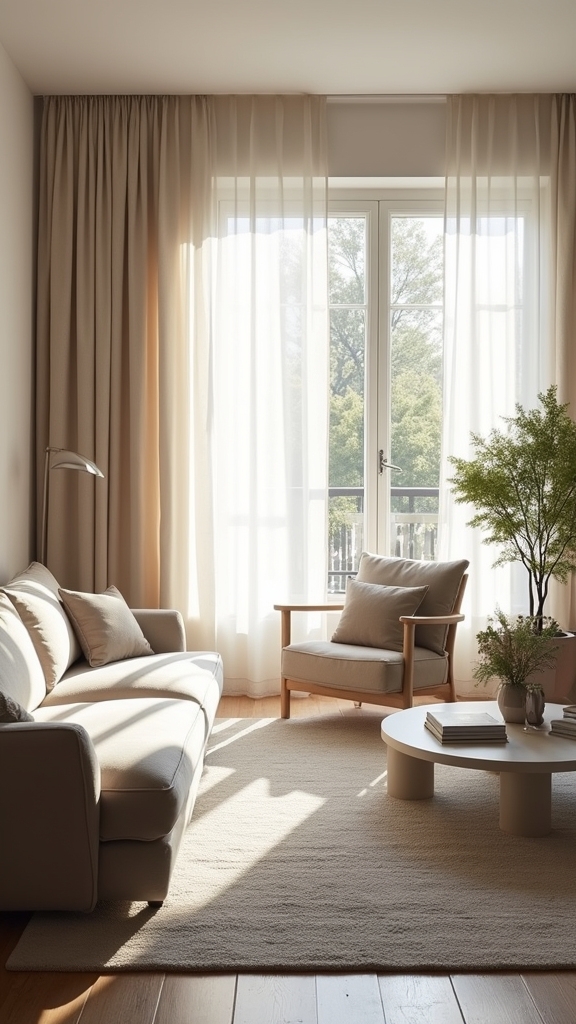
When optimizing a beige and grey living room for natural light, integrating sheer or light-colored curtains facilitates maximum illumination while maintaining privacy. This approach leverages the room’s exposure to create an airy, open environment that aligns with contemporary minimalist sensibilities.
Strategic placement of mirrors augments the influx of natural light, reflecting brightness throughout the space and visually expanding the interior. To prevent obstruction, designers recommend avoiding heavy furniture near window areas, ensuring unimpeded light flow.
Selecting light-toned furnishings—such as muted beiges and soft greys—works synergistically with the enhanced daylight, reinforcing a soft, modern aesthetic. Additionally, utilizing wall paints in shades like greige or cream further amplifies brightness, providing a cohesive and luminous backdrop that accentuates the neutral color palette.
Incorporating Greenery
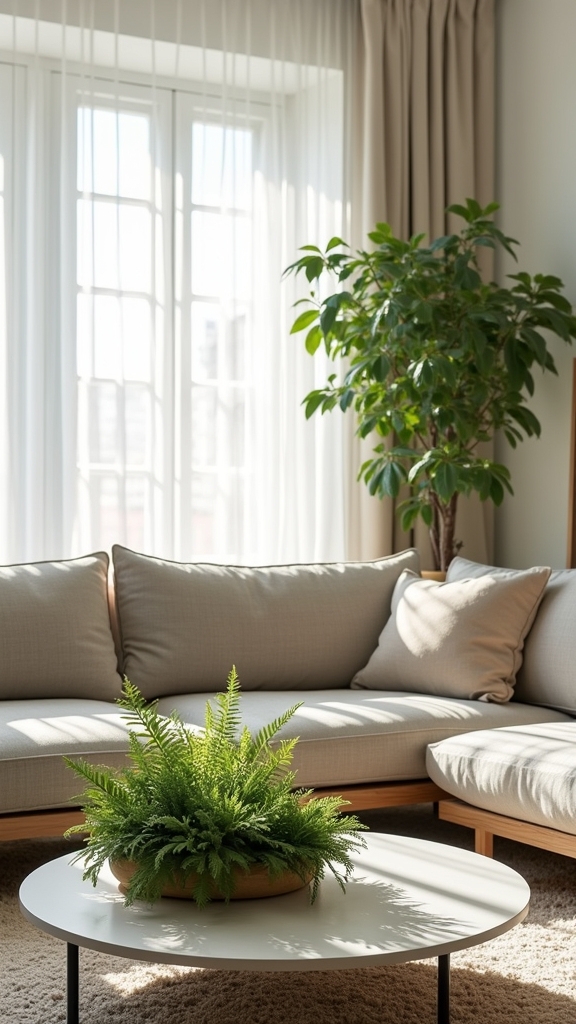
Although beige and grey living rooms are lauded for their understated elegance, the introduction of greenery injects dynamic contrast and biophilic appeal into the space.
Incorporating greenery within a beige and grey living palette not only enlivens the environment but also enhances visual balance and tranquility. Designers leverage houseplants to soften the clean lines typical of modern interiors, ensuring the space feels inviting yet sophisticated.
Utilizing planters in harmonious hues maintains cohesion, allowing plants to serve as organic focal points. Proper placement further optimizes both aesthetics and plant health.
For inspiration, consider the following:
- Snake plants for sculptural verticality
- Cascading pothos on minimalist shelving
- Ferns in textured grey planters
- Groupings near expansive windows
- Raised stands to accentuate leafy silhouettes
Greenery therefore enhances beige and grey living with both style and wellness benefits.
Statement Artwork Integration
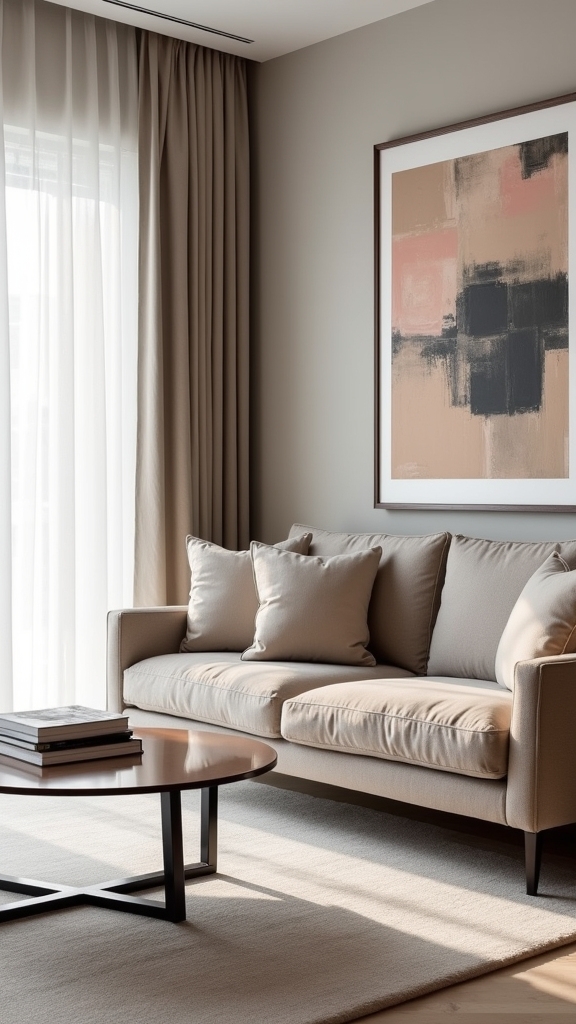
Centering a living room’s aesthetic around statement artwork establishes a deliberate focal point that punctuates the restrained tones of beige and grey schemes. Selecting large-scale canvases with bold hues or abstract forms infuses visual interest while maintaining cohesion through integrated beige and grey shades. Framed prints or photographs with grey-toned frames enhance depth and elegance, subtly echoing the color palette. Metallic-accented artwork—featuring elements of gold or silver—introduces a layer of sophistication to the soft, neutral backdrop. For prime impact, artwork should be positioned at eye level and contrasted with wall color, ensuring it commands attention within the overall decor. This considered approach transforms artwork from mere decoration to a dynamic anchor in contemporary living room design.
| Statement Artwork Tip | Design Benefit |
|---|---|
| Bold abstract canvases | Enhanced visual interest |
| Beige & grey color integration | Cohesive color palette |
| Grey-toned frames | Added depth and elegance |
| Metallic accents | Sophisticated, glamorous touch |
| Eye-level placement | Maximized focal point impact |
Chic Contemporary Furniture
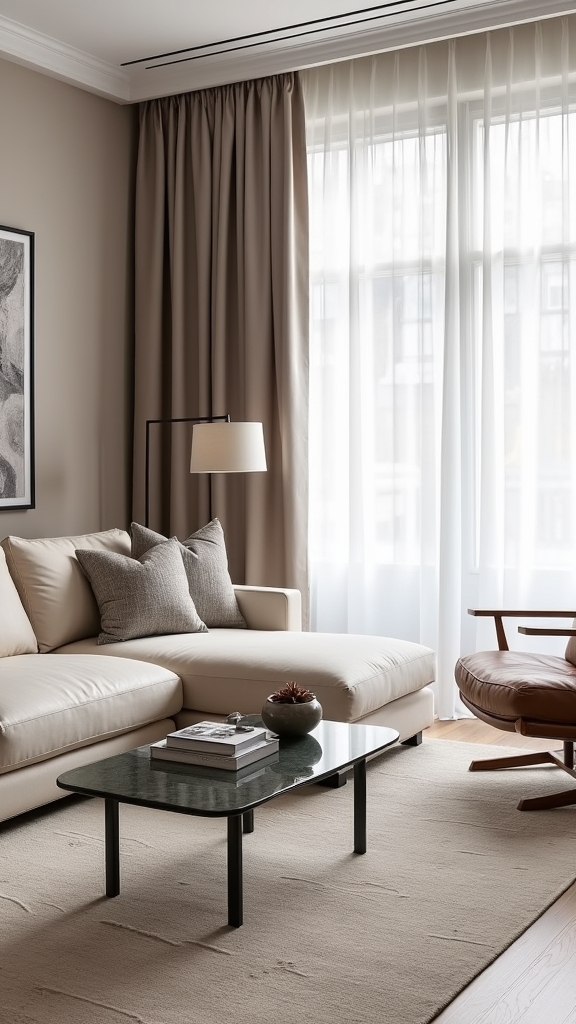
Chic contemporary furniture establishes a refined foundation for modern living rooms, emphasizing clean lines, restrained forms, and a subtle interplay of beige and grey.
Chic contemporary furniture creates a sophisticated living room backdrop, blending sleek lines with the understated harmony of beige and grey.
Within interior design, these elements yield a sophisticated environment where functionality and aesthetics converge. Neutral-toned sofas, upholstered in soft grey or beige, anchor the space with understated elegance. Metallic accents introduce a polished contrast, while carefully selected materials and finishes enhance visual depth.
The following features exemplify the core principles of chic contemporary furniture:
- Minimalist grey sofa with beige accent pillows for balanced comfort
- Metallic coffee table with gold or silver finish for a subtle luxe effect
- Multi-functional storage ottomans in coordinating hues to promote organization
- Velvet grey accent chair for tactile interest
- Beige boucle sofa contributing layered texture and warmth
Scandinavian Simplicity
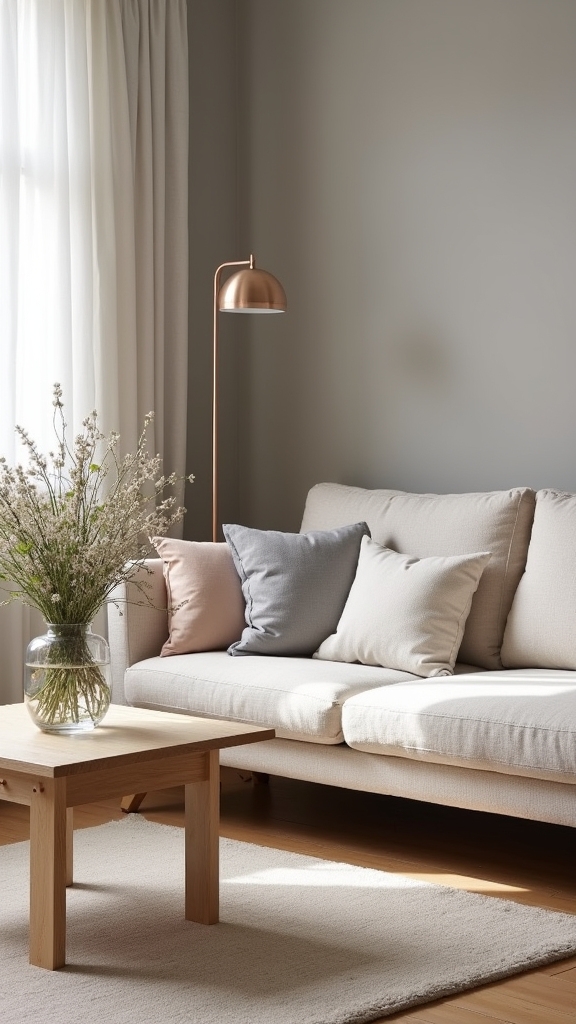
Rooted in minimalism, Scandinavian simplicity distills living room design to its essential elements, favoring clean lines, functional layouts, and an uncluttered aesthetic.
This approach is characterized by a restrained palette—soft beige and nuanced shades of grey—which amplifies natural light, enhancing the sense of openness and tranquility.
Finishes such as pale wood, textured wool, and crisp cotton introduce organic warmth and tactile interest, offsetting the pared-back architecture.
Light-coloured furnishings, chosen for their ergonomic design and visual lightness, are complemented by subtle, intentional accent pieces, ensuring the space feels curated yet inviting.
Expansive windows with sheer drapery are integral, maximizing daylight and fostering a seamless indoor-outdoor connection.
Scandinavian simplicity remains a benchmark for those seeking a harmonious, trend-forward beige and grey living room.
Country Comfort With Vintage Details

While contemporary spaces often emphasize sleekness, the country comfort aesthetic distinguishes itself through the integration of vintage details and tactile materials.
This approach leverages neutral tones—particularly beige and soft grey—as a serene canvas for layered textures and curated antique finds. The result is a living room with a sense of warmth and nostalgia, achieved through strategic materiality and accentuation.
Neutral tones like beige and soft grey set a tranquil stage for cozy textures and carefully chosen vintage accents.
Designers blend reclaimed wood, natural fibers, and timeworn finishes to evoke a lived-in charm, while subtle injections of earthy hues further enhance the palette.
- Reclaimed wood coffee tables and shelving units for organic texture
- Burlap cushions and knitted throws layered across neutral-toned seating
- Antique decor pieces, such as vintage clocks or farmhouse signage
- Mason jars repurposed as vases or candle holders
- Woven baskets for functional, rustic storage
Frequently Asked Questions
Can You Put Grey and Beige Together in a Living Room?
Combining grey and beige in a living room leverages neutral color palettes, aligning with modern design trends. This pairing offers versatility, enhances spatial harmony, and allows for sophisticated layering of textures, ensuring a contemporary, inviting aesthetic.
What Color Compliments Beige and Gray?
Designers frequently pair beige accents and grey tones with soft neutrals like cream, earthy hues such as olive green, or bold shades like blush pink. Metallic finishes introduce sophistication, while varied grey tones add depth and contemporary layering.
Can Beige and Grey Be Worn Together?
Pairing beige shades with grey tones is considered a sophisticated choice in contemporary fashion. This neutral combination leverages color harmony principles, allowing for seamless integration across textiles, elevating both casual and formal ensembles with understated, trend-conscious appeal.
How to Make a Beige Living Room Pop?
To make a beige living room pop, designers recommend integrating vibrant beige accents, incorporating modern furniture with clean lines, and utilizing layered textures. Strategic use of contrasting hues and metallic finishes further enhances visual interest and contemporary appeal.
Conclusion
Beige and grey living rooms offer a versatile canvas for innovative design, balancing warmth with modernity. Through expert layering of textures, curated accents, and trend-driven furnishings, these palettes create inviting yet sophisticated spaces. Whether embracing Scandinavian simplicity or infusing metallic luxe, the flexibility of neutral tones guarantees timeless appeal. By integrating statement art and thoughtful detailing, designers achieve depth and character while maintaining a soft, contemporary aesthetic that remains at the forefront of interior design trends.
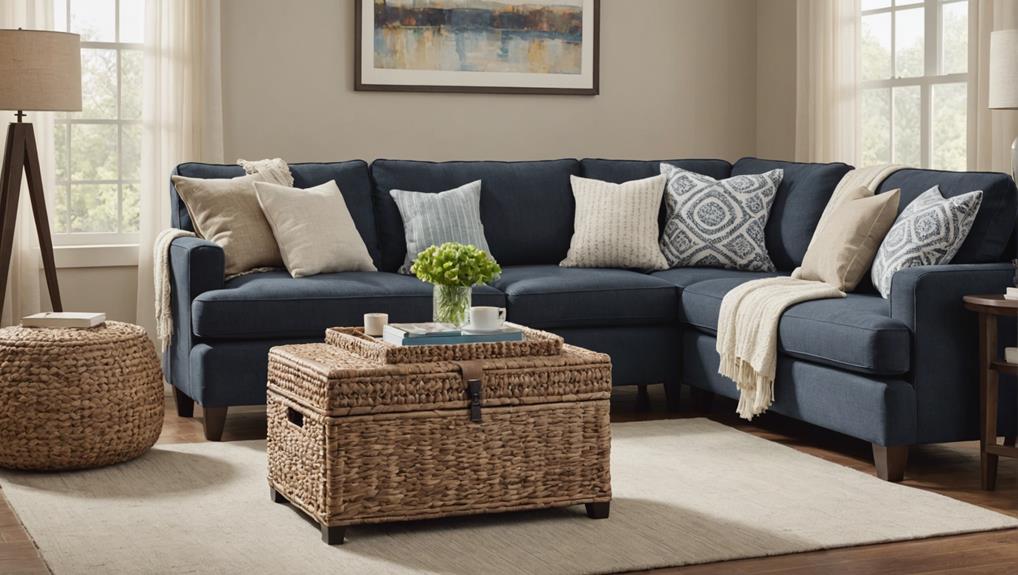
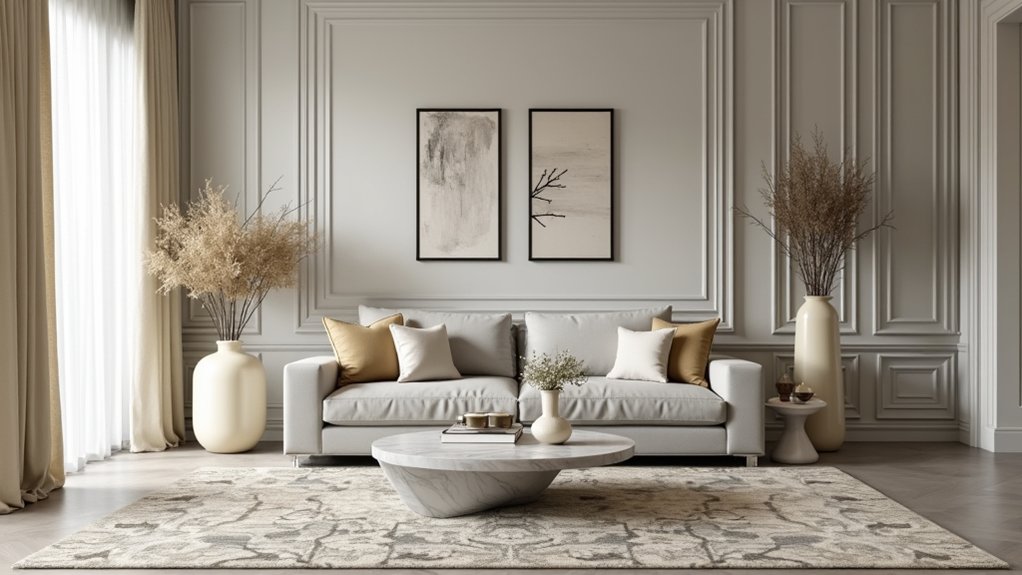
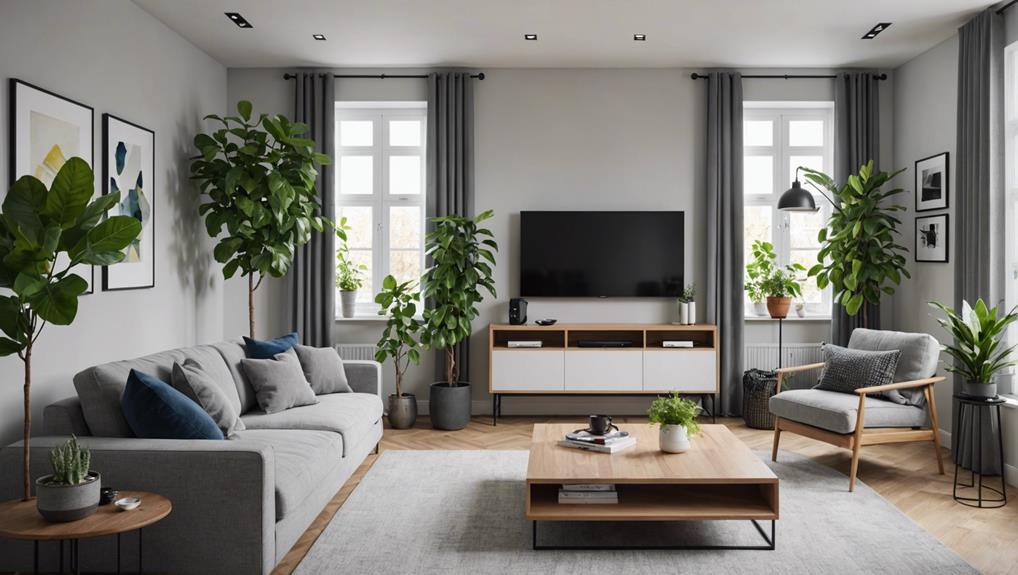
Leave a Reply